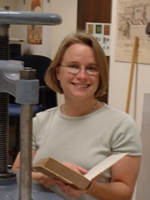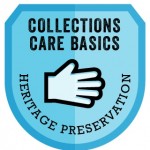This six-part course introduced basic collections care principles and practices and answered frequently asked questions. It is a part of the Caring for Yesterday’s Treasures—Today series.
In addition to webinar recording links below, you will also see transcripts of those recordings, resources that were compiled by the course instructors, and PowerPoint presentations.
Webinar 1: Overview: Agents of Deterioration and the Need for Collections Care Wednesday, January 9, 2013
2:00 – 3:30 pm EST
Instructor: Donia Conn
What do we mean by collections care, preservation, and conservation? Who can do it? With limited staff and resources, how do you prioritize the work each entails? This session highlighted the seen and unseen agents that cause collections damage and deterioration and the simple policies and procedures that can be put in place to protect collections.
CLICK HERE FOR THE WEBINAR 1 RECORDING
For closed captions, please access this via this link.
PowerPoint Presentation:
Overview: Agents of Deterioration and the Need for Collections Care
Suggested Reading and Additional Resources:
Model Preservation Policies (Ohio Memory Project)
Guidelines for Reappraisal and Deaccessioning (Society of American Archivists)
Deaccessioning: It’s Not A Four-Letter Word Webinar (AASLH Small Museums Online Community)
Sample Library Deaccessioning Policy [mid-page] (Cal Poly San Luis Obispo, Robert E. Kennedy Library)
Solving Collections Management Mysteries (link to publication for purchase) (Rebecca A. Buck and Jean Allman Gilmore, University of Chicago Press, 2007)
Ten Agents of Deterioration (AIC Wiki)
Museum Handbook, Part I (2012), Chapter 3: Preservation: Getting Started(National Park Service)
SC6000 and Other Surface Coatings for Leather: Chemical Composition and Effectiveness (Tish Brewer, 2004, University of Texas)
Red Rot Cocktail (DrinkBoston.com)
reCollections: Caring for Collections Across Australia (2005), Chapter 3: Damage and decay (Collections Australia Network)
reCollections: Caring for Collections Across Australia (2005), Chapter 4: Managing collections (Collections Australia Network)
Basic preservation for library and archive collections (Preservation Advisory Centre)
Building Blocks for a Preservation Policy (National Preservation Office)
Webinar 2: Collections Environment: Practical Solutions for Imperfect Places
Thursday, January 10, 2013
2:00 – 3:30 pm EST
Instructor: Tara Kennedy
This session explained how temperature, relative humidity, light levels, and air quality in collection storage areas can help or hurt archives and artifacts. It discussed how to monitor and interpret these conditions. Recognizing that many libraries, archives, museums, and historical societies are located in older buildings with less sophisticated environmental control systems, this session offered solutions on how to protect collections in less-than-ideal conditions.
CLICK HERE FOR THE WEBINAR 2 RECORDING
For closed captions, please access this via this link.
PowerPoint Presentation:
Collections Environment: Practical Solutions for Imperfect Places
Suggested Reading and Additional Resources:
IPI’s Guide to Sustainable Preservation Practices for Managing Storage Environments (Image Permanence Institute) Available for purchase.
IPI’s eClimate Notebook (Image Permanence Institute)
Registration for IPI’s FREE webinars on the environment (Image Permanence Institute)
Infrared and Ultraviolet Light (Canadian Conservation Institute)
Webinar Tour of the Canadian Conservation Institute’s Online Light Damage Calculator (Connecting to Collections Online Community)
Gradient Sleeves for blocking visible light in fluorescent tubes (Ergomart.com)
Minimum Efficiency Reporting Values (MERV) for filtration levels chart
Information about LED lighting and light sensitive materials (American Institute for Conservation)
Webinars about LED lighting (Connecting to Collections Online Community)
UV and Visible Light Filtering Window Films (Samantha Springer, Western Association of Art Conservators Newsletter, May 2008)
UV-Blocking Window Films for Use in Museums–Revisited (Colleen Boye, Frank Preusser, Terry Schaeffer, Western Association of Art Conservators Newsletter, January 2010)
Property Care White Paper Choice and Installation of UV Protection (Historic New England)
Vince Condella describes relative humidity and dew point (Fox6 Milwaukee)
Webinars about dataloggers (Connecting to Collections Online Community)
Dehumidifier capacity and other tips (applianceaid.com)
Dehumidifiers Buyers Guide
Silica Gel Calculators
Webinar 3: Storage and Handling
Tuesday, January 15, 2013
2:00 – 3:30 pm EST
Instructor: Donia Conn
One of the major causes of damage to collections comes from handling or moving—even by the most experienced or careful individuals. Fortunately, when collections are stored appropriately, handling becomes safer and easier. This session discussed how to store collections so that staff, volunteers, and researchers can access them in the safest possible manner.
CLICK HERE FOR THE WEBINAR 3 RECORDING
For closed captions, please access this via this link.
PowerPoint Presentation:
Storage and Handling
Suggested Reading and Additional Resources:
Conserve O Grams, Section 4 Museum Collections Storage (National Park Service)
reCollections Caring for Collections Across Australia, Chapter 6: Handling, transportation, storage and display (Collections Australia Network)
Museum Handbook, Part I (2012), Chapter 7: Museum Collection Storage (National Park Service)
Library and archive storage furniture (Preservation Advisory Centre)
Video on Making a Protective Book Box and PDF Instructions (Family Tree Magazine)
Video on How to Make a Four-Flap Enclosure (Rachel Hoff)
Preservation Leaflet: Protecting Books with Custom-Fitted Boxes (Northeast Document Conservation Center)
Pollutants in the Museum Environment (Pamela Hatchfield, Archetype Books, 2007)
Cold Storage: A Long-Term Preservation Strategy for Film-Based Photographic Materials video tutorials and web site (National Park Service)
C2C Online Community Webinar: Cold Storage for Film-Based Photographic Materials (Theresa A. Voellinger, National Park Services’ Harpers Ferry Center)
C2C Online Community Webinar: Flag Rolling and Storage (Anne Ennes, Textile Conservator, Museum Conservation Services at the National Park Service, Harpers Ferry Center)
C2C Online Community Webinar: Handling and Exhibition of Potentially Hazardous Artifacts in Museum Collections (Neil Cockerline)
Conserv O Gram: Creating a Microclimate Box for Metal Storage (Dana K. Senge, Conservator, National Park Service, Intermountain Region Museum Services Program)
Conserv O Gram: How to Select Gloves for Collections Staff (Claire S. Barker, Research Assistant, Arizona State Museum)
National Archives Guidelines on Fastened Documents (National Archives and Records Administration)
Collections Care Tips and Guidelines for Library and Home Collections (Preservation Directorate, Library of Congress)
Caring for Your Treasures (American Institute for Conservation)
Saving Your Treasures (NET Nebraska PBS and Nebraska State Historical Society)
Taking Care (articles on collections care topics) (Museum Conservation Institute, Smithsonian Institution)
Wyoming State Museum Collections Care Manual (Wyoming Department of State Parks and Cultural Resources)
Different labeling methods (video) (South Australian Community History)
General Collections Handling Guidelines (article) (South Australian Community History)
Storage Containers, Supports, and Mounts (article) (Minnesota Historical Society)
Storage Furniture (article) (Minnesota Historical Society)
Caring for Cultural Objects: Collections Management Tips (video) (Burke Museum of Natural History and Culture)
Saving Your Treasures: How to Fold & Roll Textiles for Storage (video) (NET Nebraska PBS and Nebraska State Historical Society)
Handling Museum Objects (article) (Heritage & Libraries Branch, Ontario Ministry of Culture)
The Care and Handling of Objects (article) (New Bedford Whaling Museum)
Artifact and Rare Book Handling: To Glove or Not to Glove? (video) (Minnesota Historical Society)
Volunteer Training Bank (articles and presentations) (Museum of London)
Care and Handling of Books (video) (Yale University Library)
The Fundamentals of Book Care in Five Easy Lessons (video) (George Mason University Libraries)
Conservation and Collections Care (video) (Cadbury Research Library)
Handling Harvard’s Special Collections (video) (Harvard College Library)
Webinar 4: Pest Management
Wednesday, January 16, 2013
2:00 – 3:30 pm EST
Instructor: Donia Conn
Pests are a common collections care concern. No matter how fastidious your institution may be in limiting food and drink in collections areas, insect and vermin infestations can happen almost anywhere. Collections can also be acquired showing evidence of infestation or prior pest damage. This session answered all the pest management questions that might be bugging you.
CLICK HERE FOR THE WEBINAR 4 RECORDING
For closed captions, please access this via this link.
PowerPoint Presentation:
Pest Management
Suggested Reading and Additional Resources:
Museum Handbook, Part I (2012), Chapter 5: Biological Infestations (National Park Service)
Conserve O Gram 3/7: Monitoring Insect Pests With Sticky Traps (August 1998) (National Park Service)
Managing pests in paper-based collections (Preservation Advisory Centre)
MuseumPests.net and if interested join the PestList
Museum Pests (Insects Limited, Inc.)
Integrated Pest Management Check List (Smithsonian Institution)
Conserv O Gram 3/6: An Insect Pest Control Procedure: The Freezing Process (July 1994) (National Park Service)
Using Heat to Eliminate Bedbugs in Books (post on MuseumPests.net)
Preservation at the National Archives: Bird Guano and Mold Contamination (National Archives and Records Administration)
Webinar 5: Mold!
Thursday, January 17, 2013
2:00 – 3:30 pm EST
Instructor: Tara Kennedy
Mold is another frequent hazard in collections. This session reviewed how to identify mold, deal safely with a mold outbreak, and how to prevent it from occurring in the first place. It also discussed how mold might affect a variety of formats in your institution, from books and paper to leather and textiles.
CLICK HERE FOR THE WEBINAR 5 RECORDING
(Audio failed to record on this webinar, however, closed captioning can be seen on the bottom of the screen or you may view a rebroadcast of this webinar that Tara Kennedy did on February 11, 2013.)
For closed captions, please access this via this link.
PowerPoint Presentation:
Eek! Mold! Help!
Suggested Reading and Additional Resources:
Mold in Libraries (Cornell University Library Preservation and Conservation)
reCollections Caring for Collections Across Australia: Damage and Decay (pdf download) (Heritage Collections Council, 1998)
Conserv O Gram 3/4: Mold: Prevention of Microorganism Growth in Museum Collections (August 2007) (National Park Service)
Mould Outbreak–An Immediate Response (Canadian Conservation Institute)
Emergency Recovery Vendors: Mold Remediation (pdf download) (compiled by Tara Kennedy)
C2C Online Community Webinar: Why do Old Books Smell and Other Adventures with Odors in Collections (Tara Kennedy)
Webinar 6: Staff and Volunteer Management for Collections Care
Wednesday, January 23, 2013
2:00 – 3:30 pm EST
Instructor: Donia Conn
We can’t do this work alone—so this session shared advice on how to train and supervise staff and volunteers who might be helping you with collections care. While it is important to be cautious and deliberate, expanding your collections care team can help you achieve your goals more quickly and create new advocates for preservation.
CLICK HERE FOR THE WEBINAR 6 RECORDING
For closed captions, please access this via this link.
Power Point Presentation:
Staff and Volunteer Management for Collections Care
Suggested Reading and Additional Resources:
reCollections Caring for Collections Across Australia, Chapter 5: Managing People (Collections Australia Network)
Sample Volunteer Application (Yale Peabody Museum)
Taking Care (articles on collections care topics) (Museum Conservation Institute, Smithsonian Institution)
Wyoming State Museum Collections Care Manual (Wyoming Department of State Parks and Cultural Resources)
In Safe Hands? (webinars) (The British Library)
Saving Your Treasures (videos and articles) (NET Nebraska PBS and Nebraska State Historical Society)
Different labeling methods (video) (South Australian Community History)
General Collections Handling Guidelines (article) (South Australian Community History)
Storage Containers, Supports, and Mounts (article) (Minnesota Historical Society)
Storage Furniture (article) (Minnesota Historical Society)
Caring for Cultural Objects: Collections Management Tips (video) (Burke Museum of Natural History and Culture)
Saving Your Treasures: How to Fold & Roll Textiles for Storage (video) (NET Nebraska PBS and Nebraska State Historical Society)
Handling Museum Objects (article) (Heritage & Libraries Branch, Ontario Ministry of Culture)
The Care and Handling of Objects (article) (New Bedford Whaling Museum)
Artifact and Rare Book Handling: To Glove or Not to Glove? (video) (Minnesota Historical Society)
Volunteer Training Bank (articles and presentations) (Museum of London)
Care and Handling of Books (video) (Yale University Library)
The FUNdamentals of Book Care in Five Easy Lessons (video) (George Mason University Libraries)
Conservation and Collections Care (video) (Cadbury Research Library)
Handling Harvard’s Special Collections (video) (Harvard College Library)
Murder in the Stacks (Library Preservation) (video) (Columbia University)
Test Your Awareness: Do the Test (video) (Transport for London)
Test Your Awareness: Whodunnit? (video) (Transport for London)
Sustainable Preservation Practices for Managing Storage Environments (register for free webinars) (Image Permanence Institute)
Links to Organizations that Offer Collections Care Training (Connecting to Collections Care Resources:Professional Development, Training)
Housekeeping Schedule (article) (South Australian Community History)
Useful Collections Care Resources:
Caring For: Collections (Canadian Conservation Institute)
RE-ORG (UNESCO and ICCROM)
Taking Care (Smithsonian Museum Conservation Institute)
Preservation Advisory Centre (British Library)
Preservation Directorate (Library of Congress)
Digital Preservation (Library of Congress)
Preservation (National Archives)
INSTRUCTORS

Donia Conn has worked in conservation and preservation for the past 18 years, specializing in book conservation and preservation training. She is a preservation consultant and adjunct faculty for the Simmons College Graduate School of Library and Information Science teaching Preservation Management and Collections Maintenance. For the Northeast Document Conservation Center she presented workshops and webinars on preservation and digitization topics, responded to technical inquiries from around the world, and consulted with institutions on disaster planning and preservation issues. Donia is a Professional Associate of the American Institute for Conservation of Historic and Artistic Works. She earned her BA in Mathematics from St. Olaf College and her MLIS with Advanced Certificate in Conservation from the University of Texas-Austin.

Tara Kennedy has over a decade of experience in the preservation and conservation of paper artifacts. She currently works as the Preservation Field Services Librarian at Yale University, and as a preservation consultant for institutions around the United States. She is a graduate of the University of Texas at Austin’s Preservation and Conservation Studies program and holds an BA in Art History from Northwestern University.





